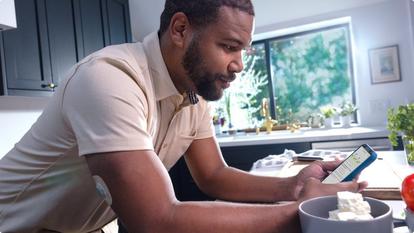Glucose basics
Research insights: How glucose tracking enhances GLP-1 therapy
Published: Jun. 30, 2025
Updated: Aug. 20, 2025
2 min read

The content in this article should not be taken as medical advice. Please consult with your healthcare provider regarding your individual health needs.
GLP-1 therapy with medications like Ozempic and Mounjaro are becoming more common as part of the toolkit for supporting weight loss and managing type 2 diabetes. They’re effective at lowering glucose and helping many people avoid more invasive treatments down the line.
In fact, the American Diabetes Association recently updated its Standards of Care to recommend GLP-1s as a first-line option (alongside lifestyle changes like weight management through diet and exercise) for people managing type 2 diabetes or those at high risk for cardiovascular or kidney disease. That’s a big shift from the traditional “start with metformin and wait” approach. And it’s part of a larger recognition that early intervention can change the trajectory of chronic conditions.
Still, medication is just one piece of the puzzle. New research from the American Diabetes Association shows that combining GLP-1s with glucose tracking—especially through continuous glucose monitors (CGMs) or glucose biosensors—can lead to even greater improvements in A1C.

How glucose tracking makes GLP-1s more effective
A recent study looked at over 4,000 people living with type 2 diabetes who weren’t using insulin. Some used glucose tracking tools, some used medications like GLP-1s, and some used both.
The results clearly showed that those who used CGMs saw significantly higher A1C reductions than those who didn’t. This was true regardless of the diabetes management medication they were prescribed. And when CGMs were used alongside GLP-1s or other non-insulin therapies, the improvement was even greater.
What’s behind that boost? It comes down to awareness. Glucose tracking helps you connect the dots between what’s happening in your body and what you’re doing each day. It’s one thing to take a weekly injection; it’s another to actually see how your glucose responds to a walk after dinner, or how that “healthy” smoothie spikes your glucose more than expected.
That kind of personalized feedback can reinforce your medication’s effect while also supporting meaningful lifestyle changes. By providing real-time insights into how your body responds to various activities, foods, and routines, glucose tracking empowers you to make adjustments that complement GLP-1 based therapy. Over time, this synergy can help cultivate healthier habits, turning isolated successes into sustained progress.

Beyond the numbers
A glucose biosensor like Stelo that tracks your glucose 24/7 helps turn insights into action to help you build healthy habits. Instead of guessing whether your routine or medication is working, you can see the trends play out day by day.
You’ll start spotting patterns, which can help you understand how physical activity, food combinations, and their timing affect you. And that insight builds confidence, especially when you’re still figuring out what works.
It can also motivate behavior change, helping you turn short-term wins into long-term habits. Stelo helps you stay consistent by helping you course-correct with less stress and more information. In the end, it’s a way to make powerful therapies like GLP-1s even more effective, and progress more sustainable.

The path to lasting change
Glucose tracking isn’t meant to replace GLP-1s, just to help you make the most of it. Real change comes from understanding how your body responds, day in and day out. Glucose biosensors help you stay connected to what’s working, adjust when it’s not, and build habits that support lasting progress. Because the goal isn’t just lower numbers. It’s feeling more in tune with your body, gaining confidence in your choices, and building a little more momentum every day.
*For Stelo app compatibility, visit stelo.com/compatibility

Curated & reviewed by: Jami Klein,
RN, BSN, CDCES
RN, BSN, CDCES
Jami Klein is a registered nurse and certified diabetes care and education specialist with extensive experience in both clinical settings and diabetes industry.
